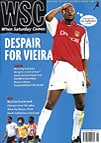 Roger Lytollis reckons the fall into semi-pro football is feared more than ever
Roger Lytollis reckons the fall into semi-pro football is feared more than ever
Hold the back page: the third division wasn’t very good last season. How else could miserably ordinary sides like Hartlepool and Blackpool make the play-offs? For every quality player there were dozens of Gary Brabins and Steve Torpeys. Cheltenham were typical. In only their second League season any romance was long gone. Their reliance on negative, strong-arm tactics left most opponents looking like extras from Gladiator by the end of the afternoon’s “entertainment”.
The argument that more overseas players at the top means more homegrown talent oozing down to the lower divisions was not borne out by what I saw this year. With so many teams battling relegation until the final weeks, fear of defeat took precedence over any thoughts of style. A division full of teams playing Dodge The Conference is hardly an environment in which youngsters are likely to thrive.
Don’t try and tell anyone in the Third that the Conference is “the new fourth division”. The fall into semi-pro football is more feared than ever, given that the last four relegated clubs have failed to return. The drop in Third Division standards was typified last season by Darlington. Under David Hodgson a year earlier they were an entertaining outfit. Without their highly paid stars they were reduced to a long-ball team, as chairman George Reynolds took on the mantle of Michael Knighton in promising big and delivering sod all.
Jan Molby’s Kidderminster stood out as a footballing side but proved too brittle to sustain a challenge. The lack of style was partly due to the closeness of the table. There was little difference in quality from top to bottom. This resulted in many tight, tense and downright dull games. Carlisle bridged the gap in the second half of the season by relying on all-out defence at home: a revolutionary tactic that proved too much for a succession of promotion candidates.
The top three were a class above the rest, largely because of their superior resources in the transfer market. Like most Micky Adams sides the success of champions Brighton was built on no-nonsense defending, with centre-halves Danny Cullip and Andy Crosby outstanding. Cardiff’s spending of almost £1.5 million dwarfed that of every other club. They bought quality in Daniel Gabbidon while the underrated Paul Brayson outshone the club’s expensive forward signings. Chesterfield were generous buyers too, a policy wholeheartedly endorsed by the Football League.
Few players looked to have the potential to go on to greater things. Despite Bobby Zamora’s goals for Brighton it is doubtful whether he has the refinement to be successful outside the bottom two divisions. Lee Hodges produced some sublime moments for Scunthorpe, although he showed a lack of ambition in re-signing for them rather than moving on a Bosman. One drawback of Barnet’s fall – how many fans will miss the trip to Underhill? – was the relegation of Darren Currie, an enigmatic player who combines moments of genius with world-class indifference.
The player most likely to succeed at a higher level is perhaps Hartlepool’s midfielder Tommy Miller. At the time of writing he seems unlikely to be at the Victoria Ground for much longer. In Ches-terfield winger Ryan Williams and Carlisle goalkeeper Matt Glennon, Hull have bought two of the outstanding players in the division. Maybe the basement will now have at least one side worth watching. And the decision not to introduce a second relegation place should mean teams will not be crippled by even more fear next time around.
From WSC 174 August 2001. What was happening this month